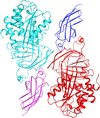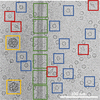issue contents
November 2024 issue

Cover illustration: This structure of heat-shock protein 47 in space group C2 was obtained in a study aimed at optimizing its crystallization for the development of a structure-based drug-design system [Kish et al. (2024), Acta Cryst. F80, 302–313].
research communications
This study successfully determined the crystal structure of human serpin B9 at 1.9 Å resolution and identified notable structural differences surrounding helix D, providing a potential target for the development of anticancer therapeutics.
PDB reference: serpin B9, 8zcr
Open  access
access
 access
accessThe crystal structure of proliferating cell nuclear antigen 1 from the thermophilic archaeon A. pernix was determined at 2.00 Å resolution. This crystal structure revealed unique features in the N-terminus, including a PIP-box-like sequence, suggesting potential interactions with other proliferating cell nuclear antigens.
A two-pronged strategy was embarked upon to obtain well diffracting crystals of heat-shock protein 47 by (i) replacing a noncleavable C-terminal His-tag with a cleavable N-terminal His-tag and (ii) developing Adnectin crystallization chaperones. Both approaches yielded better diffracting crystals, and the second approach limited the number of complexes in the asymmetric unit to only one or two, which made for less onerous model building.
Open  access
access
 access
accessThis study presents the crystal structure of transforming growth factor β type I receptor (TβR1) in complex with SB505124, highlighting the specific contacts that SB505124 makes with TβR1 and comparing these interactions with those of SB431542.
PDB reference: transforming growth factor β type I receptor, 9f6x
methods communications
Open  access
access
 access
accessCryoEM technologies are emerging as a powerful structural science tool to reveal molecular details of biological systems, but have lacked comprehensive calibration standards for biomacromolecular workflow benchmarking. A cryoEM calibration sample mixture is introduced that may be used to evaluate more than the achievable information limit of the instrument by providing a workflow-validation and educational tool for biological samples.

 journal menu
journal menu

















![[publBio]](/logos/publbio.gif)





